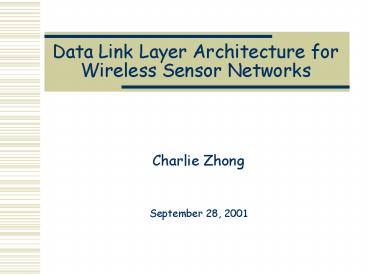Data Link Layer Architecture for Wireless Sensor Networks - PowerPoint PPT Presentation
1 / 29
Title:
Data Link Layer Architecture for Wireless Sensor Networks
Description:
Tu-berlin: combined tuning of RF power and MAC ... Power on time. Time spent on utilizing TX and RX ... The time network stays connected (T1): max power consumption ... – PowerPoint PPT presentation
Number of Views:44
Avg rating:3.0/5.0
Title: Data Link Layer Architecture for Wireless Sensor Networks
1
Data Link Layer Architecture for Wireless Sensor
Networks
- Charlie Zhong
- September 28, 2001
2
Outline
- Background
- Proposed solution
- Future work
3
I. Background
- Differentiation
- Sensor network requirements
- Data link layer functions and requirements
- Challenges
- Existing work
4
How is wireless sensor network different?
- Energy consumption control
- Disaster mitigation
- Traffic management
- Not much Qos, mobility, data rate
- but easy maintenance, long operation time,
minimal human involvement
5
Sensor Network Requirements
- Desired performance (e.g. how good the
environment control is) - Easy setup
- Simple maintenance/diagnostics
- Low cost
- Security
- Scalability, size etc.
6
Data Link Layer
Application
- Design requirements
- Supports required functions
- Communications with required reliability
- Location as part of information
- Power-efficient
- Distributed
- Requires no global synchronization
- Scalable, robust
- Easy setup and maintenance
- DLL functions
- transfers data between network and physical
layers - power control, error control, access control
- computes location
- maintains neighborhood info
Transport
Network
Data Link
Physical
7
Challenges
- What to optimize
- The design of a subsystem is very dependent on
that of another - How to compare two different designs
- Need a design method and analysis
8
Existing Works
- 802.11 power management need global
synchronization - UCLA distributed scheduling
- GTE topology control
- Tu-berlin combined tuning of RF power and MAC
- Metrics proposed are not accurate, very few
qualitative comparison, not for entire data link
layer
9
Metrics Proposed
- Power on time
- Time spent on utilizing TX and RX
- Total number of correctly transmitted packets
during the lifetime of battery - Signal energy per successfully transmitted bits
10
What is power?
- Communications
- Value comes from information bits, not from OH
bits, acks, handshakes to setup - Values comes from the transfer from source to
destination, not every hop - Processing
- Value comes from how you use information
- Encoding/compression/redundancy
11
Our Solution
- A systematic approach
- Identify the goal for optimization
- Perform functional break down
- Understand the complicated inter-dependency
between the design of different subsystems - Quantify design metrics, know the tradeoffs
- Compare different algorithms
- Predict the direction for improvements
12
Clean the Mess
13
Outline
- Background
- Proposed solution
- Future work
14
Our Solution
- Optimization goal
- UML functional description
- Case study power control subsystem
- Interactions between subsystems
- Design metrics
- Comparison of two algorithms
- Direction for improvements
15
Optimization Goal
- Cost local battery source
- Value desired functions
- Goal the time the desired functions can be
maintained should be as long as possible for
fixed energy cost
Network Life
16
Network Life
- Definition the time network stays functioning
for given power supply - How to quantify it
- The time network stays connected (T1) max power
consumption - T1the time network is still functioning after
the 1st node dies
17
Functional Description
Unified Modeling Language
18
VCC Implementation
Virtual Component Co-design
19
System Operation
Initialization
Maintenance
Data Communication
20
Case study power control
- Controls the transmit power
- Topology control for desired connectivity
- Compensate topology changes incurred by mobility
and dead nodes - Controls a nodes neighborhood
21
Interactions with other Subsystems
Collisions
Load balancing
Connectivity
Spatial reuse
Retransmissions
Performance degradation
Battery drain
Error performance
22
Design Metrics
Simplified model
BER
Connectivity
Radius r Receiver sensibility C BER p
Max of retransmissions N
modulation
Collision rate
Power Control
coding
Interference
ch available
Transmit power PT
For given d, find minimum PT
- Assumptions
- Number of neighbors, or degree d, is used to
approximate node connectivity - Nodes are uniformly distributed with density D
- Channel assignment ensures every interferer is
using a different channel - There is no interference between channels
23
Target BER
p BER pkt packet error rate
M of bits/packet N max of
retransmissions Reliability prob. of packet loss
after N retransmissionspktN1 Assumptions BPSK
modulation, no coding, BSC channel Target BER
10-3 -gt packet loss rate 0.45
24
Tradeoffs
- Node connectivity kgt1 is required kgt1 is
desired to give network layer enough paths to
balance loads with - The higher PT, the higher the connectivity
- At higher PT, it is harder for channel assignment
to control collisions and interference - For given link-level reliability, there exists
optimum BER
25
Data Link Layer Tradeoffs
Reliability
Redundancy
Network
Transport
Connectivity
Traffic density
Link-level reliability
NBs
BER
NBs
interferers
Data link data rate
Collision rate
Power Control
MAC
Interference
TX power
channels
Data rate
Physical layer
26
Comparison of two algorithms
- Topology control only
- Our algorithm
27
Direction for improvement
- Pick target BER based on link-level reliability,
modulation and error control coding scheme - Jointly optimize across network and data link
layers for longer network life
28
Outline
- Background
- Proposed solution
- Future work
29
Future Work
- More accurate modeling
- Simulations
- Network implementation
- Better quantification of network life































